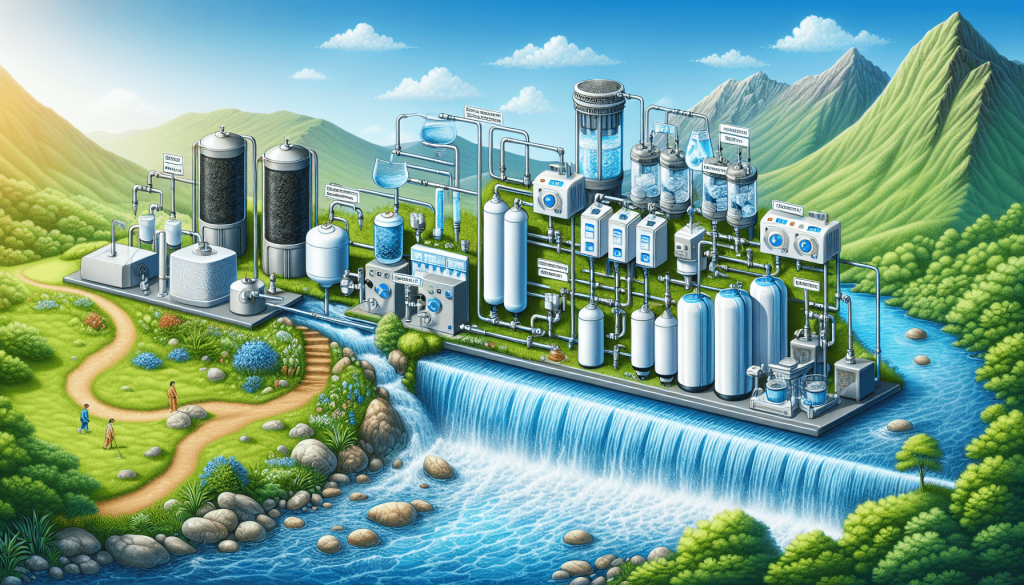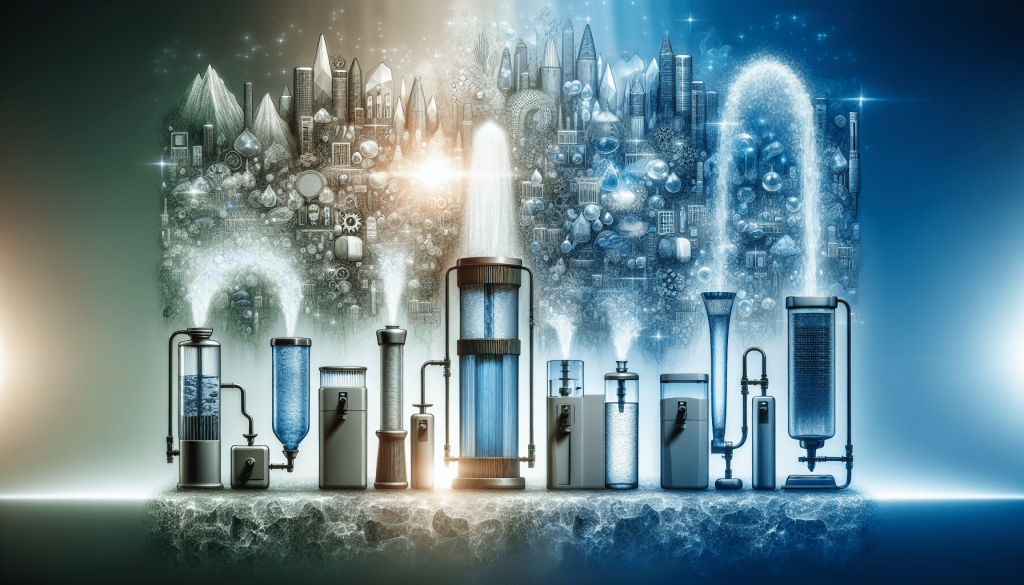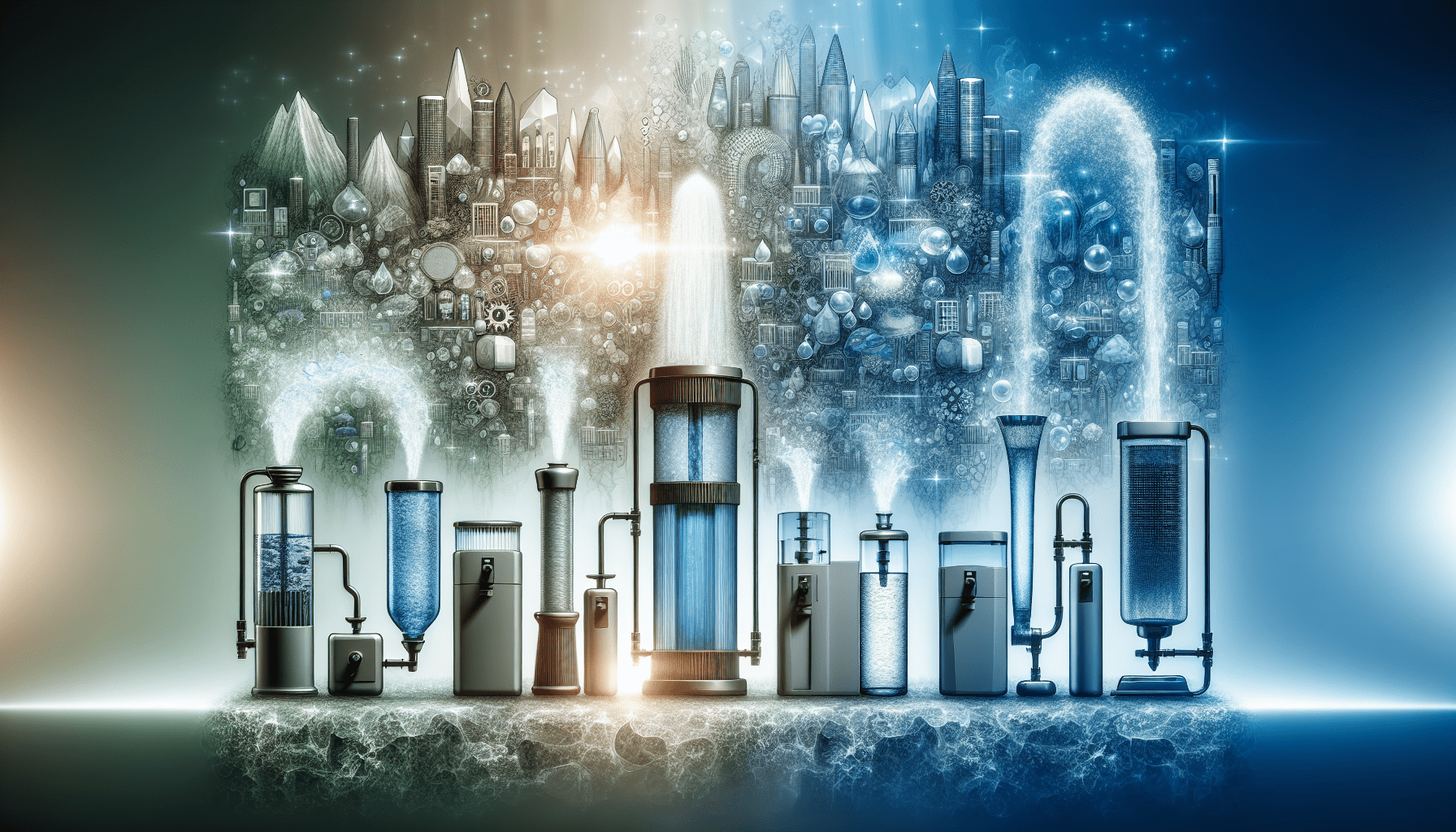In your quest to find the best water purification system, it can be overwhelming to navigate through the multitude of options available. From carbon filters to reverse osmosis, each system boasts its own benefits and advantages. But fear not, as we dive into the world of water purification, we will uncover the most effective and efficient methods to ensure your water is clean, safe, and refreshing. So sit back, grab a glass of water, and let’s explore the fascinating world of water purification systems together!

Reverse Osmosis
Reverse osmosis is a water purification process that utilizes a semipermeable membrane to remove impurities from water. The process involves applying pressure to the water, forcing it through the membrane, and leaving behind contaminants. This filtration method effectively removes a wide range of contaminants, including bacteria, viruses, heavy metals, and dissolved solids.
How does reverse osmosis work?
Reverse osmosis works through a combination of pressure and a semipermeable membrane. When you turn on the tap, water is sent through a sediment filter to remove larger particles. It then enters the reverse osmosis system, where it is pressurized and pushed through the membrane. This membrane has very tiny pores that only allow water molecules to pass through, blocking impurities. The purified water is collected, while the contaminants are flushed away.
Advantages of reverse osmosis
One major advantage of reverse osmosis is its ability to remove a wide range of contaminants, including bacteria, viruses, heavy metals, pesticides, and chemicals. It provides clean and pure drinking water, improving the taste, odor, and appearance of the water. Reverse osmosis systems are also efficient and require minimal maintenance, making them convenient for everyday use. Additionally, these systems are typically easy to install and can be customized to fit different household needs.
Disadvantages of reverse osmosis
While reverse osmosis is effective in removing contaminants, it also removes essential minerals from the water. These minerals, such as calcium and magnesium, are beneficial for our health. Therefore, some argue that reverse osmosis water may be too pure and lacking in necessary minerals. Additionally, reverse osmosis systems can be quite inefficient, as they waste a significant amount of water during the purification process. This can result in increased water bills and concerns over water conservation.
Cost of reverse osmosis systems
The cost of reverse osmosis systems can vary depending on the brand, features, and size of the system. On average, you can expect to pay anywhere from $200 to $800 for a residential reverse osmosis system. Factor in the installation costs if you’re not comfortable setting it up yourself. Additionally, regular maintenance and filter replacements should be considered, which can add to the overall cost over time. It’s important to keep these factors in mind when considering a reverse osmosis system for your home.
Activated Carbon Filtration
Activated carbon filtration is a popular method for purifying water, especially for improving taste and odor. The filtration process involves adsorption, where the activated carbon attracts and traps impurities in the water, effectively removing them.
How does activated carbon filtration work?
Activated carbon filtration utilizes a porous material, typically charcoal, that has been treated to create a large surface area for adsorption. As water flows through the carbon filter, contaminants become trapped in the activated carbon, allowing clean and purified water to pass through. The activated carbon effectively removes chlorine, volatile organic compounds (VOCs), some pesticides, and other organic compounds.
Advantages of activated carbon filtration
One of the major advantages of activated carbon filtration is its ability to remove chlorine, which can greatly improve the taste and odor of water. It also removes certain organic compounds, such as pesticides and VOCs, which can be harmful to health. Activated carbon filters are relatively affordable and easy to maintain, with filter replacements typically required every few months. Furthermore, activated carbon filtration does not remove essential minerals from the water, ensuring that you still receive beneficial nutrients.
Disadvantages of activated carbon filtration
While activated carbon filtration is effective for certain contaminants, it is not suitable for removing all types of impurities. It is not as effective in removing heavy metals, dissolved solids, or microorganisms such as bacteria and viruses. Additionally, activated carbon filters can become saturated over time, reducing their effectiveness. Regular filter replacements are necessary to ensure optimal filtration. Finally, activated carbon filtration systems may not be suitable for high-flow water usage, as the filtration process can be slower compared to other methods.
Cost of activated carbon filtration systems
The cost of activated carbon filtration systems can vary depending on the type of system and brand. Basic activated carbon filter pitchers can range from $20 to $40, while under-sink activated carbon systems can cost between $100 and $300. Higher-end whole-house activated carbon systems can cost upwards of $1,000. Replacement filters should also be considered, with prices ranging from $10 to $50, depending on the brand and model.
Ultraviolet (UV) Treatment
Ultraviolet (UV) treatment is a water purification method that utilizes ultraviolet light to destroy microorganisms in the water. It is effective in killing bacteria, viruses, and other harmful pathogens.
How does UV treatment work?
UV treatment works by exposing the water to ultraviolet light, which damages the genetic material of microorganisms, preventing them from reproducing and rendering them harmless. The water flows through a chamber where UV lamps emit powerful light at a specific wavelength. The exposure to UV light eliminates the risks posed by harmful microorganisms, making the water safe to drink.
Advantages of UV treatment
UV treatment offers several advantages, including its ability to effectively kill a wide range of microorganisms without the use of chemicals. It does not alter the taste, odor, or pH of the water, making it an ideal choice for those who prefer the natural properties of water. UV treatment is also environmentally friendly, as it does not produce any harmful byproducts or waste. Additionally, UV systems require minimal maintenance, typically involving the replacement of UV lamps once a year.
Disadvantages of UV treatment
One disadvantage of UV treatment is that it does not remove other impurities such as heavy metals, chemicals, or sediment from the water. Therefore, UV treatment is often used in conjunction with other filtration methods to ensure comprehensive water purification. Additionally, UV systems require a continuous power supply to operate, which may be a concern during power outages. It is also important to note that UV systems do not provide a residual effect, meaning the purified water can become recontaminated if not stored properly.
Cost of UV treatment systems
The cost of UV treatment systems can vary depending on the size, brand, and features of the system. Residential UV systems typically range from $200 to $800, depending on the flow rate and additional features such as UV intensity monitoring. It is also important to consider the cost of replacement UV lamps, which need to be replaced annually and can cost anywhere from $50 to $200, depending on the system.
Distillation
Distillation is a traditional method of water purification that involves heating water to create steam, then condensing the steam back into water to remove impurities. It effectively removes contaminants that have higher boiling points than water.
How does distillation work?
Distillation works by heating water in a chamber to create steam. The steam rises and passes through a cooling system, where it condenses back into liquid form. This process effectively separates impurities from the water, as most contaminants have higher boiling points and are left behind during the evaporation process. The condensed water is collected as purified water, free from impurities.
Advantages of distillation
One advantage of distillation is its ability to remove a wide range of contaminants, including heavy metals, bacteria, viruses, dissolved solids, and volatile organic compounds. It provides a high level of purification and produces clean, safe drinking water. Distilled water is often described as pure and tasteless, making it a popular choice for certain applications, such as laboratory use. Distillation units are relatively easy to operate and require minimal maintenance.
Disadvantages of distillation
One major disadvantage of distillation is that it removes essential minerals from the water. These minerals, such as calcium and magnesium, are beneficial for our health. Therefore, some argue that distilled water may not be as beneficial for drinking purposes. Distillation is also an energy-intensive process, requiring a significant amount of electricity or another heat source to heat the water and produce steam. This can result in higher energy costs compared to other purification methods.
Cost of distillation systems
The cost of distillation systems can vary depending on the size, brand, and features of the unit. Basic countertop distillers can range from $100 to $300, while larger whole-house distillation systems can cost upwards of $1,000. It is important to factor in the energy costs associated with distillation, as it requires a continuous supply of heat to operate effectively.

Ceramic Filters
Ceramic filters are a type of water filtration system that use porous ceramic material to remove impurities from water. These filters work through a combination of mechanical and physical filtration processes.
How do ceramic filters work?
Ceramic filters consist of a cylindrical or disc-shaped ceramic element that contains tiny pores. When water passes through these pores, contaminants, such as bacteria, sediment, rust, and protozoa, are physically trapped on the surface of the ceramic. The filtered water then flows out, leaving behind the impurities. Ceramic filters provide a barrier that effectively removes these contaminants, resulting in clean and safe drinking water.
Advantages of ceramic filters
One major advantage of ceramic filters is their ability to remove harmful bacteria and protozoa from water, making it safe to drink. They are particularly effective in areas where microbial contamination of water is a concern. Ceramic filters are also relatively affordable and easy to maintain. They can be cleaned and reused multiple times, making them a cost-effective long-term solution for water purification. Additionally, ceramic filters do not require electricity to operate, making them suitable for use in areas with limited access to power.
Disadvantages of ceramic filters
While ceramic filters are effective in removing bacteria and protozoa, they may not be as effective in removing other contaminants, such as heavy metals, chemicals, or viruses. Therefore, they are often used in conjunction with other filtration methods to ensure comprehensive water purification. Ceramic filters can also be fragile and may break if not handled with care. Regular cleaning is necessary to maintain their effectiveness, as the pores can become clogged over time.
Cost of ceramic filter systems
The cost of ceramic filter systems can vary depending on the size, brand, and additional features of the system. Basic ceramic filter pitchers can range from $20 to $50, while under-sink ceramic filter systems can cost between $100 and $300. Larger countertop or gravity-fed ceramic filters can cost upwards of $500. It is important to consider the cost of replacement ceramic filters, which typically need to be replaced every few months and can range from $10 to $50, depending on the brand and model.
Ion Exchange
Ion exchange is a water purification method that involves the exchange of ions in water with ions of a similar charge from a resin. This process effectively removes dissolved minerals, such as calcium, magnesium, and certain heavy metals, from the water.
How does ion exchange work?
Ion exchange works by passing water through a resin bed that is made up of tiny beads. These beads are coated with ions that have a similar charge to the contaminants in the water. As the water flows through the resin, the ions in the water are exchanged with the ions on the resin. This process removes the dissolved minerals and contaminants from the water, resulting in purified water.
Advantages of ion exchange
One major advantage of ion exchange is its effectiveness in removing dissolved minerals, such as calcium and magnesium, from the water. This can help improve the taste of the water and prevent the build-up of mineral deposits in appliances. Ion exchange can also remove certain heavy metals, such as lead and copper, from the water, reducing potential health risks. Additionally, ion exchange systems are relatively easy to maintain and require minimal maintenance.
Disadvantages of ion exchange
While ion exchange is effective in removing certain contaminants, it may not be as effective in removing other impurities, such as bacteria, viruses, or organic compounds. Therefore, it is often used in conjunction with other filtration methods to ensure comprehensive water purification. Additionally, ion exchange systems require regular regeneration or resin replacement to maintain their effectiveness. This process can involve the use of chemicals and additional maintenance costs.
Cost of ion exchange systems
The cost of ion exchange systems can vary depending on the size, brand, and features of the system. Basic ion exchange water softeners can range from $200 to $500, while larger whole-house systems can cost upwards of $1,000. It is important to consider ongoing maintenance costs, including the cost of salt or resin replacements, which can range from $50 to $200 per year, depending on the system.

Ozone Water Purification
Ozone water purification is a method that utilizes ozone gas to remove contaminants from water. Ozone is a powerful oxidizing agent that effectively kills bacteria, viruses, and other microorganisms.
How does ozone water purification work?
Ozone water purification involves injecting ozone gas into water, either through an ozone generator or ozone-producing device, in order to disinfect and oxidize contaminants. Ozone works by breaking down the cell walls of microorganisms, rendering them incapable of reproducing and causing harm. It can also effectively oxidize organic compounds, such as pesticides and other chemicals, making the water safe to drink.
Advantages of ozone water purification
One major advantage of ozone water purification is its ability to effectively remove harmful microorganisms, including bacteria, viruses, and parasites. It is a powerful disinfectant that provides a high level of water purification. Ozone treatment does not alter the taste, odor, or color of the water, making it a favorable choice for those who prefer the natural properties of water. Additionally, ozone breaks down rapidly, leaving no residual byproducts in the water, making it environmentally friendly.
Disadvantages of ozone water purification
One disadvantage of ozone water purification is that it may not be as effective in removing certain contaminants, such as heavy metals or dissolved solids. Therefore, ozone treatment is often used in conjunction with other filtration methods to ensure comprehensive water purification. Ozone systems can also be relatively expensive to install and may require additional equipment, such as ozone generators. Regular maintenance is necessary to keep the ozone system operating effectively.
Cost of ozone water purification systems
The cost of ozone water purification systems can vary depending on the size, brand, and features of the system. Residential ozone systems typically range from $200 to $1,000, depending on the flow rate and additional components. It is important to factor in the cost of ongoing maintenance, including the replacement of ozone generators or components, which can range from $100 to $500, depending on the system.
Carbon Block Filters
Carbon block filters are a type of water filtration system that use compressed activated carbon to remove impurities from water. These filters work through a combination of adsorption and mechanical filtration.
How do carbon block filters work?
Carbon block filters consist of a solid block of compressed activated carbon that traps and removes contaminants as water flows through it. The activated carbon has a large surface area with microscopic pores that adsorb impurities, including chlorine, volatile organic compounds, some pesticides, and other organic compounds. Carbon block filters also mechanically remove sediment and larger particles through the structure of the block.
Advantages of carbon block filters
One major advantage of carbon block filters is their ability to effectively remove chlorine, which can greatly improve the taste and odor of water. They are also effective in removing certain organic compounds, such as pesticides and volatile organic compounds, that can be harmful to health. Carbon block filters provide a high level of filtration and produce clean, great-tasting water. They are relatively affordable and easy to maintain, typically requiring filter replacements every few months.
Disadvantages of carbon block filters
While carbon block filters are effective for certain contaminants, they may not be as effective in removing heavy metals, dissolved solids, or microorganisms such as bacteria and viruses. Therefore, they are often used in combination with other filtration methods to ensure comprehensive water purification. Additionally, carbon block filters can become saturated over time, reducing their effectiveness. Regular filter replacements are necessary to maintain optimal filtration.
Cost of carbon block filter systems
The cost of carbon block filter systems can vary depending on the size, brand, and additional features of the system. Basic carbon block filter pitchers can range from $20 to $50, while under-sink carbon block filter systems can cost between $100 and $300. Whole-house carbon block systems can range from $500 to $1,000. It is important to consider the cost of replacement carbon block filters, which typically need to be replaced every few months and can range from $10 to $50, depending on the brand and model.

Granular Activated Carbon (GAC) Filters
Granular activated carbon (GAC) filters are a type of water filtration system that use loose granules of activated carbon to remove impurities from water. These filters work through a combination of adsorption and mechanical filtration.
How do GAC filters work?
GAC filters consist of a container filled with loose granules of activated carbon. As water flows through the filter, contaminants are adsorbed onto the surface of the carbon granules. This allows the GAC filter to effectively remove chlorine, volatile organic compounds, some pesticides, and other organic compounds from the water. GAC filters also mechanically remove sediment and larger particles as the water passes through the granules.
Advantages of GAC filters
One major advantage of GAC filters is their ability to effectively remove chlorine, improving the taste and odor of water. They also remove certain organic compounds, such as pesticides and volatile organic compounds, that can be harmful to health. GAC filters provide a good level of filtration and produce clean, safe drinking water. They are relatively affordable and easy to maintain, typically requiring filter replacements every few months.
Disadvantages of GAC filters
While GAC filters are effective for certain contaminants, they may not be as effective in removing heavy metals, dissolved solids, or microorganisms such as bacteria and viruses. Therefore, they are often used in combination with other filtration methods to ensure comprehensive water purification. Additionally, GAC filters can become saturated over time, reducing their effectiveness. Regular filter replacements are necessary to maintain optimal filtration.
Cost of GAC filter systems
The cost of GAC filter systems can vary depending on the size, brand, and additional features of the system. Basic GAC filter pitchers can range from $20 to $50, while under-sink GAC filter systems can cost between $100 and $300. Larger countertop or whole-house GAC filters can range from $500 to $1,000. It is important to consider the cost of replacement GAC filters, which typically need to be replaced every few months and can range from $10 to $50, depending on the brand and model.
Membrane Filtration
Membrane filtration is a water purification method that involves passing water through a semipermeable membrane to remove impurities. This process effectively removes particles, microorganisms, and dissolved substances from the water.
How does membrane filtration work?
Membrane filtration works by using a semipermeable membrane with very tiny pores that only allow water molecules to pass through, while blocking contaminants. Water is forced through the membrane under pressure, causing the impurities to be removed and retained on one side of the membrane. This results in purified water that is free from particles, microorganisms, and dissolved substances.
Advantages of membrane filtration
One major advantage of membrane filtration is its ability to effectively remove a wide range of contaminants, including bacteria, viruses, sediment, dissolved solids, and certain organic compounds. It provides a high level of purification and produces clean, safe drinking water. Membrane filtration systems are also relatively compact and can be easily installed under the sink or as a point-of-entry system. Maintenance is typically minimal, with periodic filter replacements required.
Disadvantages of membrane filtration
While membrane filtration is effective in removing contaminants, it may also remove desirable minerals from the water. These minerals, such as calcium and magnesium, are beneficial for our health. Therefore, some argue that membrane filtration may lead to demineralized water. Additionally, membrane filtration systems can be relatively expensive compared to other filtration methods. The initial cost of the system, as well as ongoing maintenance and filter replacements, should be considered.
Cost of membrane filtration systems
The cost of membrane filtration systems can vary depending on the size, brand, and features of the system. Basic under-sink membrane filtration systems can range from $200 to $500, while larger whole-house membrane systems can cost upwards of $1,000. Replacement filters should also be considered, with prices ranging from $50 to $200, depending on the brand and model.



